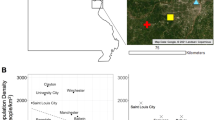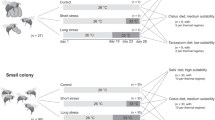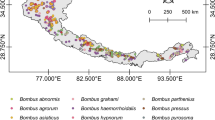Abstract
Insect pollinators such as bumblebees (Bombus spp.) are in global decline1,2. A major cause of this decline is habitat loss due to agricultural intensification3. A range of global and national initiatives aimed at restoring pollinator habitats and populations have been developed4,5. However, the success of these initiatives depends critically upon understanding how landscape change affects key population-level parameters, such as survival between lifecycle stages6, in target species. This knowledge is lacking for bumblebees, because of the difficulty of systematically finding and monitoring colonies in the wild. We used a combination of habitat manipulation, land-use and habitat surveys, molecular genetics7 and demographic and spatial modelling to analyse between-year survival of family lineages in field populations of three bumblebee species. Here we show that the survival of family lineages from the summer worker to the spring queen stage in the following year increases significantly with the proportion of high-value foraging habitat, including spring floral resources, within 250–1,000 m of the natal colony. This provides evidence for a positive impact of habitat quality on survival and persistence between successive colony cycle stages in bumblebee populations. These findings also support the idea that conservation interventions that increase floral resources at a landscape scale and throughout the season have positive effects on wild pollinators in agricultural landscapes.
This is a preview of subscription content, access via your institution
Access options
Access Nature and 54 other Nature Portfolio journals
Get Nature+, our best-value online-access subscription
$29.99 / 30 days
cancel any time
Subscribe to this journal
Receive 51 print issues and online access
$199.00 per year
only $3.90 per issue
Buy this article
- Purchase on Springer Link
- Instant access to full article PDF
Prices may be subject to local taxes which are calculated during checkout


Similar content being viewed by others
References
Williams, P. H. & Osborne, J. L. Bumblebee vulnerability and conservation world-wide. Apidologie 40, 367–387 (2009)
Cameron, S. A . et al. Patterns of widespread decline in North American bumble bees. Proc. Natl Acad. Sci. USA 108, 662–667 (2011)
Vanbergen, A. J. & The Insect Pollinators Initiative. Threats to an ecosystem service: pressures on pollinators. Front. Ecol. Environ 11, 251–259 (2013)
Department for Environment, Food & Rural Affairs. The National Pollinator Strategy: for bees and other pollinators in England. https://www.gov.uk/government/publications/national-pollinator-strategy-for-bees-and-other-pollinators-in-england (2014)
Gill, R. J. et al. Protecting an ecosystem service: approaches to understanding and mitigating threats to wild insect pollinators. Adv. Ecol. Res 54, 135–206 (2016)
Carvell, C. et al. Bumble bee species’ responses to a targeted conservation measure depend on landscape context and habitat quality. Ecol. Appl . 21, 1760–1771 (2011)
Dreier, S. et al. Fine-scale spatial genetic structure of common and declining bumble bees across an agricultural landscape. Mol. Ecol . 23, 3384–3395 (2014)
Baude, M. et al. Historical nectar assessment reveals the fall and rise of floral resources in Britain. Nature 530, 85–88 (2016)
Winfree, R., Aguilar, R., Vázquez, D. P., LeBuhn, G. & Aizen, M. A. A meta-analysis of bees’ responses to anthropogenic disturbance. Ecology 90, 2068–2076 (2009)
Garibaldi, L. A. et al. Stability of pollination services decreases with isolation from natural areas despite honey bee visits. Ecol. Lett . 14, 1062–1072 (2011)
Natural England. Countryside Stewardship Manual (Natural England catalogue code NE608, https://www.gov.uk/countrysidestewardship) (2015)
Carvell, C., Meek, W. R., Pywell, R. F., Goulson, D. & Nowakowski, M. Comparing the efficacy of agri-environment schemes to enhance bumble bee abundance and diversity on arable field margins. J. Appl. Ecol . 44, 29–40 (2007)
Wood, T. J., Holland, J. M., Hughes, W. O. H. & Goulson, D. Targeted agri-environment schemes significantly improve the population size of common farmland bumblebee species. Mol. Ecol . 24, 1668–1680 (2015)
Pywell, R. F . et al. Wildlife-friendly farming increases crop yield: evidence for ecological intensification. Proc. R. Soc. B 282, 20151740 (2015)
M’Gonigle, L. K., Ponisio, L. C., Cutler, K. & Kremen, C. Habitat restoration promotes pollinator persistence and colonization in intensively managed agriculture. Ecol. Appl . 25, 1557–1565 (2015)
Klein, A.-M . et al. Importance of pollinators in changing landscapes for world crops. Proc. R. Soc. B 274, 303–313 (2007)
Garratt, M. P. D. et al. The identity of crop pollinators helps target conservation for improved ecosystem services. Biol. Conserv . 169, 128–135 (2014)
Benton, T. Bumblebees: the Natural History & Identification of the Species found in Britain (Collins, 2006)
Beekman, M ., van Stratum, P & Lingeman, R. Diapause survival and post-diapause performance in bumblebee queens (Bombus terrestris). Entomol. Exp. Appl . 89, 207–214 (1998)
Lepais, O. et al. Estimation of bumblebee queen dispersal distances using sibship reconstruction method. Mol. Ecol . 19, 819–831 (2010)
Williams, N. M., Regetz, J. & Kremen, C. Landscape-scale resources promote colony growth but not reproductive performance of bumble bees. Ecology 93, 1049–1058 (2012)
Jha, S. & Kremen, C. Urban land use limits regional bumble bee gene flow. Mol. Ecol . 22, 2483–2495 (2013)
Redhead, J. W. et al. Effects of habitat composition and landscape structure on worker foraging distances of five bumble bee species. Ecol. Appl . 26, 726–739 (2016)
Lebreton, J.-D., Burnham, K. P., Clobert, J. & Anderson, D. R. Modeling survival and testing biological hypotheses using marked animals: a unified approach with case studies. Ecol. Monogr . 62, 67–118 (1992)
Goulson, D. et al. Effects of land use at a landscape scale on bumblebee nest density and survival. J. Appl. Ecol . 47, 1207–1215 (2010)
Jha, S & Kremen, C. Resource diversity and landscape-level homogeneity drive native bee foraging. Proc. Natl Acad. Sci. USA 110, 555–558 (2013)
Dicks, L. V. et al. How much flower-rich habitat is enough for wild pollinators? Answering a key policy question with incomplete knowledge. Ecol. Entomol . 40, 22–35 (2015)
Carvell, C., Bourke, A. F. G., Osborne, J. L. & Heard, M. S. Effects of an agri-environment scheme on bumblebee reproduction at local and landscape scales. Basic Appl. Ecol . 16, 519–530 (2015)
Nieto, A. et al. European Red List of Bees (Luxembourg: Publication Office of the European Union, 2014)
Redhead, J. W. et al. Map of land-use/land-cover and floral cover across an arable landscape in Buckinghamshire, UK. NERC Environmental Information Data Centre https://dx.doi.org/10.5285/0667cf06-f2c3-45c1-a80a-e48539b52427 (2014)
Lye, G., Park, K., Osborne, J., Holland, J. & Goulson, D. Assessing the value of Rural Stewardship schemes for providing foraging resources and nesting habitat for bumblebee queens (Hymenoptera: Apidae). Biol. Conserv . 142, 2023–2032 (2009)
Lopez-Vaamonde, C. et al. Lifetime reproductive success and longevity of queens in an annual social insect. J. Evol. Biol . 22, 983–996 (2009)
Goulson, D., Hughes, W. O. H., Derwent, L. C. & Stout, J. C. Colony growth of the bumblebee, Bombus terrestris, in improved and conventional agricultural and suburban habitats. Oecologia 130, 267–273 (2002)
Whitehorn, P. R., O’Connor, S., Wackers, F. L. & Goulson, D. Neonicotinoid pesticide reduces bumble bee colony growth and queen production. Science 336, 351–352 (2012)
Carvell, C. et al. Molecular and spatial analyses reveal links between colony-specific foraging distance and landscape-level resource availability in two bumblebee species. Oikos 121, 734–742 (2012)
Holehouse, K. A., Hammond, R. L. & Bourke, A. F. G. Non-lethal sampling of DNA from bumble bees for conservation genetics. Insectes Sociaux 50, 277–285 (2003)
Dreier, S. et al. Microsatellite genotype data for five species of bumblebee across an agricultural landscape in Buckinghamshire, UK. NERC Environmental Information Data Centre https://dx.doi.org/10.5285/6a408415-0575-49c6-af69-b568e343266d (2014)
Wang, J. Sibship reconstruction from genetic data with typing errors. Genetics 166, 1963–1979 (2004)
Bourke, A. F. G. Sex ratios in bumble bees. Phil. Trans. R. Soc. Lond. B 352, 1921–1933 (1997)
White, G. C. & Burnham, K. P. Program MARK: survival estimation from populations of marked animals. Bird Study 46, 120–139 (1999)
Carvell, C. et al. Family lineage and landscape quality data for wild bumblebee colonies across an agricultural landscape in Buckinghamshire, UK. NERC Environmental Information Data Centre http://dx.doi.org/10.5285/6be00174-6544-4156-b1df-8678f6df2034 (2016)
Carvell, C. et al. Location data of worker bumblebees across an agricultural landscape in Buckinghamshire, UK. NERC Environmental Information Data Centre http://dx.doi.org/10.5285/a60f52b8-0f9f-44f6-aca4-861cb461a0eb (2014)
Acknowledgements
We thank the CEH field team (L. Hulmes, J. Peyton, J. Savage, S. Amy, R. Chapman, G. Baron and R. MacDonald) for sampling bumblebees and conducting habitat surveys; R. Faccenda and R. Franklin of Faccenda Farms, and other landowners, for access to the Hillesden Estate and surroundings; R. Pywell and M. Nowakowski for access to the Hillesden Experimental Platform; H. Dean for data management; C. Harrower for help with graphics; H. M. Lattorff for use of his primers for the molecular discrimination of B. terrestris and B. lucorum workers; I. Warren for assistance with laboratory work; and J. Bullock and K. Schonrogge for comments on an earlier version of the manuscript. This research was supported by the Insect Pollinators Initiative (grant BB/I000925/1). The Insect Pollinators Initiative was funded jointly by the Biotechnology and Biological Sciences Research Council, the Department for Environment, Food and Rural Affairs, the Natural Environment Research Council, The Scottish Government and The Wellcome Trust, under the Living with Environmental Change Partnership. Acquisition of remote sensing data was funded by Syngenta Plc.
Author information
Authors and Affiliations
Contributions
C.C., M.S.H., A.F.G.B., S.S. and W.C.J. conceived the project and designed the study. C.C., M.S.H. and S.H. coordinated the fieldwork and modelling elements and C.C. prepared the manuscript. S.D. carried out the molecular genotyping and sibship assignments with guidance from J.W. J.W.R. developed and applied the spatial analyses and S.N.F. designed and undertook the statistical analyses. All authors contributed to writing and critiquing the manuscript.
Corresponding author
Ethics declarations
Competing interests
The authors declare no competing financial interests.
Additional information
Reviewer Information Nature thanks T. Ergon and the other anonymous reviewer(s) for their contribution to the peer review of this work.
Publisher's note: Springer Nature remains neutral with regard to jurisdictional claims in published maps and institutional affiliations.
Extended data figures and tables
Extended Data Figure 1 Variation and correlations between habitat and land-use variables across the study landscape.
Plots show (i) histograms to demonstrate variation within each habitat/land-use variable along the diagonal; (ii) scatter plots showing correlations between variables (top, right) with a linear model trend line fitted to the correlation data (in red, only extended to the limits of the data) and a 1:1 line (in pale grey) and (iii) correlation coefficients with their significance (bottom, left) where *P < 0.05, **P < 0.01 and ***P < 0.001. Axis values are standardised and represent proportional cover of the different habitat variables within 1,000 m of the estimated colony locations, with variable names following the same order and shortened format as presented in Extended Data Table 5. Each point on the scatter plots represents one family lineage (n = 456). Arable, arable field cover; Mixed, mixed semi-natural vegetation cover; Nest, nesting habitat cover; Spring, spring flower cover; Summer, summer flower cover; Queen, queen-visited spring flower cover; Spr + Sum, combined queen-visited and worker-preferred flower cover; Worker, worker-preferred flower cover.
Extended Data Figure 2 Simulation-based assessment of robustness of the modified CJS model.
a–d, The estimated parameter values aggregate around the true values. Frequency distributions of parameter estimates are shown, from 1,000 simulated datasets, each of 2,000 families. Parameters plotted are shown for a–d as indicated. a, φ1: true value = 0.6. b, φ2: true value = 0.5. c, λ1: true value = 3. d, λ2: true value = 2. To align with the real data in which some families were not detected at the founding queen (Q1) stage, if at all, data were simulated assuming a detection probability of 0.4 at the Q1 stage.
Extended Data Figure 3 Goodness of fit for the modified mark–recapture model.
See Extended Data Table 3 for estimated probabilities. a–d, Frequency distributions across all species are shown. a, Observed counts of workers (W1i). b, Expected counts of workers (W1i). c, Observed counts of second-generation queens (Q2i). d, Expected counts of second-generation queens (Q2i).
Supplementary information
Supplementary Information
This file contains Supplementary Text and Data, Supplementary Tables 1-2 and additional references. (PDF 271 kb)
Supplementary Data
This file contains the R code. (TXT 3 kb)
PowerPoint slides
Rights and permissions
About this article
Cite this article
Carvell, C., Bourke, A., Dreier, S. et al. Bumblebee family lineage survival is enhanced in high-quality landscapes. Nature 543, 547–549 (2017). https://doi.org/10.1038/nature21709
Received:
Accepted:
Published:
Issue Date:
DOI: https://doi.org/10.1038/nature21709
This article is cited by
-
Safeguarding pollinators requires specific habitat prescriptions and substantially more land area than suggested by current policy
Scientific Reports (2023)
-
Review on flower-visiting behaviour of orthopterans and setting priorities for further studies
Biologia Futura (2023)
-
Urban wild bees benefit from flower-rich anthropogenic land use depending on bee trait and scale
Landscape Ecology (2023)
-
Parasites, depredators, and limited resources as potential drivers of winter mortality of feral honeybee colonies in German forests
Oecologia (2023)
-
Which interventions contribute most to the net effect of England’s agri-environment schemes on pollination services?
Landscape Ecology (2023)
Comments
By submitting a comment you agree to abide by our Terms and Community Guidelines. If you find something abusive or that does not comply with our terms or guidelines please flag it as inappropriate.



